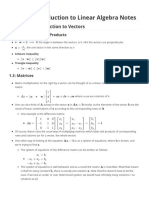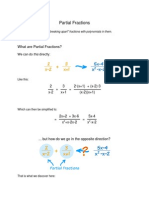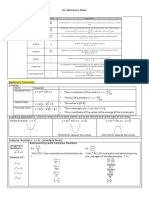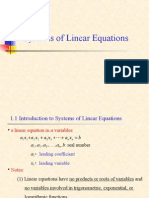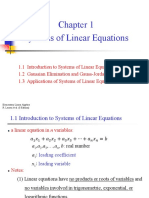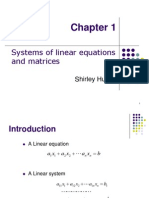Professional Documents
Culture Documents
Systems of Linear Equations
Systems of Linear Equations
Uploaded by
RainingGirlOriginal Description:
Original Title
Copyright
Available Formats
Share this document
Did you find this document useful?
Is this content inappropriate?
Report this DocumentCopyright:
Available Formats
Systems of Linear Equations
Systems of Linear Equations
Uploaded by
RainingGirlCopyright:
Available Formats
Chapter 1
Systems of Linear Equations
1.1 Introduction to Systems of Linear Equations
1.2 Gaussian Elimination and Gauss-Jordan Elimination
Elementary Linear Algebra
R. Larsen et al. (6 Edition)
2/39
1.1 Introduction to Systems of Linear Equations
a linear equation in n variables:
a
1
,a
2
,a
3
,,a
n
, b: real number
a
1
: leading coefficient
x
1
: leading variable
Notes:
(1) Linear equations have no products or roots of variables and
no variables involved in trigonometric, exponential, or
logarithmic functions.
(2) Variables appear only to the first power.
Elementary Linear Algebra: Section 1.1, p.2
3/39
Ex 1: (Linear or Nonlinear)
7 2 3 ) ( = + y x a
2
2
1
) ( = + z y x b t
0 10 2 ) (
4 3 2 1
= + + x x x x c
2
2 1
4 )
2
sin ( ) ( e x x d =
t
2 ) ( = + z xy e 4 2 ) ( = y e f
x
0 3 2 sin ) (
3 2 1
= + x x x g
4
1 1
) ( = +
y x
h
power first not the
l Exponentia
functions ric trigonomet
Linear
Linear
Linear
Linear
Nonlinear
Nonlinear
Nonlinear
Nonlinear
power first not the
Elementary Linear Algebra: Section 1.1, p.2
4/39
a solution of a linear equation in n variables:
Solution set:
the set of all solutions of a linear equation
b x a x a x a x a
n n
= + + + +
3 3 2 2 1 1
,
1 1
s x = ,
2 2
s x = ,
3 3
s x = ,
n n
s x =
b s a s a s a s a
n n
= + + + +
3 3 2 2 1 1
such
that
Elementary Linear Algebra: Section 1.1, pp.2-3
5/39
Ex 2 (Parametric representation of a solution set)
4 2
2 1
= + x x
If you solve for x
1
in terms of x
2
, you obtain
By letting you can represent the solution set as
And the solutions are or
{ } R t t t e | ) , 2 4 (
, 2 4
2 1
x x =
t x =
2
2 4
1
t x =
{ } R s s s e | ) 2 , (
2
1
a solution: (2, 1), i.e.
1 , 2
2 1
= = x x
Elementary Linear Algebra: Section 1.1, p.3
6/39
a system of m linear equations in n variables:
m n mn m m m
n n
n n
n n
b x a x a x a x a
b x a x a x a x a
b x a x a x a x a
b x a x a x a x a
= + + + +
= + + + +
= + + + +
= + + + +
3 3 2 2 1 1
3 3 3 33 2 32 1 31
2 2 3 23 2 22 1 21
1 1 3 13 2 12 1 11
Consistent:
A system of linear equations has at least one solution.
Inconsistent:
A system of linear equations has no solution.
Elementary Linear Algebra: Section 1.1, p.4
7/39
Notes:
Every system of linear equations has either
(1) exactly one solution,
(2) infinitely many solutions, or
(3) no solution.
Elementary Linear Algebra: Section 1.1, p.5
8/39
Ex 4: (Solution of a system of linear equations)
(1)
(2)
(3)
1
3
=
= +
y x
y x
6 2 2
3
= +
= +
y x
y x
1
3
= +
= +
y x
y x
solution one exactly
number inifinite
solution no
lines ng intersecti two
lines coincident two
lines parallel two
Elementary Linear Algebra: Section 1.1, p.5
9/39
Ex 5: (Using back substitution to solve a system in row echelon form)
(2)
(1)
2
5 2
=
=
y
y x
Sol: By substituting into (1), you obtain 2 = y
1
5 ) 2 ( 2
=
=
x
x
The system has exactly one solution: 2 , 1 = = y x
Elementary Linear Algebra: Section 1.1, p.6
10/39
Ex 6: (Using back substitution to solve a system in row echelon form)
(3)
(2)
(1)
2
5 3
9 3 2
=
= +
= +
z
z y
z y x
Sol: Substitute into (2) 2 = z
1
5 ) 2 ( 3
=
= +
y
y
and substitute and into (1)
1 = y 2 = z
1
9 ) 2 ( 3 ) 1 ( 2
=
= +
x
x
The system has exactly one solution:
2 , 1 , 1 = = = z y x
Elementary Linear Algebra: Section 1.1, pp.6-7
11/39
Equivalent:
Two systems of linear equations are called equivalent
if they have precisely the same solution set.
Notes:
Each of the following operations on a system of linear
equations produces an equivalent system.
(1) Interchange two equations.
(2) Multiply an equation by a nonzero constant.
(3) Add a multiple of an equation to another equation.
Elementary Linear Algebra: Section 1.1, p.7
12/39
Ex 7: Solve a system of linear equations (consistent system)
(3)
(2)
(1)
17 5 5 2
4 3
9 3 2
= +
= +
= +
z y x
y x
z y x
Sol:
(4)
17 5 5 2
5 3
9 3 2
(2) (2) (1)
= +
= +
= +
+
z y x
z y
z y x
(5)
1
5 3
9 3 2
(3) (3) 2) ( (1)
=
= +
= +
+
z y
z y
z y x
Elementary Linear Algebra: Section 1.1, p.7
13/39
So the solution is (only one solution) 2 , 1 , 1 = = = z y x
(6)
4 2
5 3
9 3 2
(5) (5) (4)
=
= +
= +
+
z
z y
z y x
2
5 3
9 3 2
) 6 ( (6)
2
1
=
= +
= +
z
z y
z y x
Elementary Linear Algebra: Section 1.1, p.8
14/39
Ex 8: Solve a system of linear equations (inconsistent system)
(3)
(2)
(1)
1 3 2
2 2 2
1 3
3 2 1
3 2 1
3 2 1
= +
=
= +
x x x
x x x
x x x
Sol:
) 5 (
) 4 (
2 4 5
0 4 5
1 3
(3) (3) ) 1 ( (1)
(2) (2) 2) ( (1)
3 2
3 2
3 2 1
=
=
= +
+
+
x x
x x
x x x
Elementary Linear Algebra: Section 1.1, p.9
15/39
So the system has no solution (an inconsistent system).
2 0
0 4 5
1 3
) 5 ( ) 5 ( ) 1 ( ) 4 (
3 2
3 2 1
=
=
= +
+
x x
x x x
statement) false (a
Elementary Linear Algebra: Section 1.1, p.9
16/39
Ex 9: Solve a system of linear equations (infinitely many solutions)
(3)
(2)
(1)
1 3
1 3
0
2 1
3 1
3 2
= +
=
=
x x
x x
x x
Sol:
(3)
(2)
(1)
1 3
0
1 3
) 2 ( ) 1 (
2 1
3 2
3 1
= +
=
=
x x
x x
x x
(4)
0 3 3
0
1 3
(3) (3) (1)
3 2
3 2
3 1
=
=
=
+
x x
x x
x x
Elementary Linear Algebra: Section 1.1, p.10
17/39
0
1 3
3 2
3 1
=
=
x x
x x
then
,
,
, 1 3
3
2
1
t x
R t t x
t x
=
e =
=
t x =
3
let
,
3 2
x x =
3 1
3 1 x x + =
So this system has infinitely many solutions.
Elementary Linear Algebra: Section 1.1, p.10
18/39
Keywords in Section 1.1:
linear equation:
system of linear equations:
leading coefficient:
leading variable:
solution:
solution set:
parametric representation:
consistent: ()
inconsistent: ()
equivalent:
19/39
(4) For a square matrix, the entries a
11
, a
22
, , a
nn
are called
the main diagonal entries.
1.2 Gaussian Elimination and Gauss-Jordan Elimination
mn matrix:
(
(
(
(
mn m m m
n
n
n
a a a a
a a a a
a a a a
a a a a
3 2 1
3 33 32 31
2 23 22 21
1 13 12 11
rows m
columns n
(3) If , then the matrix is called square of order n. n m=
Notes:
(1) Every entry a
ij
in a matrix is a number.
(2) A matrix with m rows and n columns is said to be of size mn .
Elementary Linear Algebra: Section 1.2, p.14
20/39
Ex 1: Matrix Size
] 2 [
(
0 0
0 0
(
2
1
0 3 1
(
(
4 7
2 2
t e
1 1
2 2
4 1
2 3
Note:
One very common use of matrices is to represent a system
of linear equations.
Elementary Linear Algebra: Section 1.2, p.15
21/39
a system of m equations in n variables:
m n mn m m m
n n
n n
n n
b x a x a x a x a
b x a x a x a x a
b x a x a x a x a
b x a x a x a x a
= + + + +
= + + + +
= + + + +
= + + + +
3 3 2 2 1 1
3 3 3 33 2 32 1 31
2 2 3 23 2 22 1 21
1 1 3 13 2 12 1 11
(
(
(
(
=
mn m m m
n
n
n
a a a a
a a a a
a a a a
a a a a
A
3 2 1
3 33 32 31
2 23 22 21
1 13 12 11
(
(
(
=
m
b
b
b
b
2
1
(
(
(
=
n
x
x
x
x
2
1
b Ax =
Matrix form:
Elementary Linear Algebra: Section 1.2, p.14
22/39
Augmented matrix:
] [
3
2
1
3 2 1
3 33 32 31
2 23 22 21
1 13 12 11
b A
b
b
b
b
a a a a
a a a a
a a a a
a a a a
m mn m m m
n
n
n
=
(
(
(
(
A
a a a a
a a a a
a a a a
a a a a
mn m m m
n
n
n
=
(
(
(
(
3 2 1
3 33 32 31
2 23 22 21
1 13 12 11
Coefficient matrix:
Elementary Linear Algebra: Section 1.2, pp.14-15
23/39
Elementary row operation:
j i ij
R R r :
(1) Interchange two rows.
i i
k
i
R R k r ) ( :
) (
(2) Multiply a row by a nonzero constant.
j j i
k
ij
R R R k r + ) ( :
) (
(3) Add a multiple of a row to another row.
Row equivalent:
Two matrices are said to be row equivalent if one can be obtained
from the other by a finite sequence of elementary row operation.
Elementary Linear Algebra: Section 1.2, pp.15-16
24/39
Ex 2: (Elementary row operation)
(
(
1 4 3 2
4 3 1 0
3 0 2 1
(
(
1 4 3 2
3 0 2 1
4 3 1 0
12
r
(
(
2 1 2 5
0 3 3 1
1 3 2 1
(
(
2 1 2 5
0 3 3 1
2 6 4 2
) (
1
2
1
r
(
(
8 13 3 0
1 2 3 0
3 4 2 1
(
(
2 5 1 2
1 2 3 0
3 4 2 1
) 2 (
13
r
Elementary Linear Algebra: Section 1.2, p.16
25/39
Ex 3: Using elementary row operations to solve a system
17 5 5 2
5 3
9 3 2
= +
= +
= +
z y x
z y
z y x
17 5 5 2
4 3
9 3 2
= +
= +
= +
z y x
y x
z y x
Linear System
(
(
(
17 5 5 2
4 0 3 1
9 3 2 1
(
(
(
17 5 5 2
5 3 1 0
9 3 2 1
Elementary Linear Algebra: Section 1.2, pp.17-18
Associated
Augemented Matrix
Elementary
Row Operation
(
(
(
1 1 1 0
5 3 1 0
9 3 2 1
2 2 1
) 1 (
12
) 1 ( : R R R r +
3 3 1
) 2 (
13
) 2 ( : R R R r +
1
5 3
9 3 2
=
= +
= +
z y
z y
z y x
26/39
3 3 2
) 1 (
23
) 1 ( : R R R r +
Linear System
(
(
(
4 2 0 0
5 3 1 0
9 3 2 1
2
1
1
=
=
=
z
y
x
Elementary Linear Algebra: Section 1.2, pp.17-18
(
(
(
2 1 0 0
5 3 1 0
9 3 2 1
Associated
Augemented Matrix
Elementary
Row Operation
4 2
5 3
9 3 2
=
= +
= +
z
z y
z y x
3 3
)
2
1
(
3
)
2
1
( : R R r
2
5 3
9 3 2
=
= +
= +
z
z y
z y x
27/39
Row-echelon form: (1, 2, 3)
(1) All row consisting entirely of zeros occur at the bottom
of the matrix.
(2) For each row that does not consist entirely of zeros,
the first nonzero entry is 1 (called a leading 1).
(3) For two successive (nonzero) rows, the leading 1 in the higher
row is farther to the left than the leading 1 in the lower row.
Reduced row-echelon form: (1, 2, 3, 4)
(4) Every column that has a leading 1 has zeros in every position
above and below its leading 1.
Elementary Linear Algebra: Section 1.2, p.18
28/39
form) echelon
- row (reduced
form)
echelon - (row
Ex 4: (Row-echelon form or reduced row-echelon form)
(
(
2 1 0 0
3 0 1 0
4 1 2 1
(
(
(
1 0 0 0 0
4 1 0 0 0
2 3 1 0 0
3 1 2 5 1
(
(
0 0 0 0
3 1 0 0
5 0 1 0
(
(
(
0 0 0 0
3 1 0 0
2 0 1 0
1 0 0 1
(
(
3 1 0 0
1 1 2 0
4 3 2 1
(
(
4 2 1 0
0 0 0 0
2 1 2 1
form)
echelon - (row
form) echelon
- row (reduced
Elementary Linear Algebra: Section 1.2, p.18
29/39
Gaussian elimination:
The procedure for reducing a matrix to a row-echelon form.
Gauss-Jordan elimination:
The procedure for reducing a matrix to a reduced row-echelon
form.
Notes:
(1) Every matrix has an unique reduced row echelon form.
(2) A row-echelon form of a given matrix is not unique.
(Different sequences of row operations can produce
different row-echelon forms.)
Elementary Linear Algebra: Section 1.2, p.19
30/39
(
(
(
4 5 6 5 4 2
12 8 0 2 0 0
28 12 4 6 8 2
12
r
The first nonzero
column
Produce leading 1
Zeros elements below leading 1
leading 1
Produce leading 1
The first nonzero column
Ex: (Procedure of Gaussian elimination and Gauss-Jordan elimination)
(
(
(
4 5 6 5 4 2
28 12 4 6 8 2
12 8 0 2 0 0
(
(
(
4 5 6 5 4 2
12 8 0 2 0 0
14 6 2 3 4 1
) (
1
2
1
r
(
(
(
24 17 0 5 0 0
12 8 0 2 0 0
14 6 2 3 4 1 ) 2 (
13
r
Submatrix
Elementary Linear Algebra: Section 1.2, Addition
31/39
Zeros elements below leading 1
Zeros elsewhere
leading 1
Produce leading 1
leading 1
form) echelon - (row
(
(
(
24 17 0 5 0 0
6 4 0 1 0 0
14 6 2 3 4 1
) (
2
2
1
r
(
(
(
6 3 0 0 0 0
6 4 0 1 0 0
14 6 2 3 4 1
) 5 (
23
r
(
(
(
2 1 0 0 0 0
6 4 0 1 0 0
14 6 2 3 4 1
)
3
1
(
3
r
Submatrix
form) echelon - (row
form) echelon - row (reduced
Elementary Linear Algebra: Section 1.2, Addition
(
(
(
2 1 0 0 0 0
2 0 0 1 0 0
2 0 2 3 4 1
) 4 (
32
r
(
(
(
2 1 0 0 0 0
2 0 0 1 0 0
8 0 2 0 4 1
) 3 (
21
r
(
(
(
2 1 0 0 0 0
6 4 0 1 0 0
2 0 2 3 4 1
) 6 (
31
r
form) echelon - (row
32/39
Ex 7: Solve a system by Gauss-Jordan elimination method
(only one solution)
17 5 5 2
4 3
9 3 2
= +
= +
= +
z y x
y x
z y x
Sol:
matrix augmented
(
(
17 5 5 2
4 0 3 1
9 3 2 1
(
(
(
1 1 1 0
5 3 1 0
9 3 2 1 ) 2 (
13
) 1 (
12
,
r r
(
(
(
4 2 0 0
5 3 1 0
9 3 2 1
) 1 (
23
r
(
(
2 1 0 0
1 0 1 0
1 0 0 1
) 9 (
31
) 3 (
32
) 2 (
21
, ,
r r r
2
1
1
=
=
=
z
y
x
form) echelon - (row
form) echelon - row (reduced
Elementary Linear Algebra: Section 1.2, pp.22-23
(
(
2 1 0 0
5 3 1 0
9 3 2 1
)
2
1
(
3
r
33/39
Ex 8Solve a system by Gauss-Jordan elimination method
(infinitely many solutions)
1 5 3
0 2 4 2
2 1
3 1 1
= +
= +
x x
x x x
(
1 3 1 0
2 5 0 1
) 2 (
21
) 1 (
2
) 3 (
12
) (
1
, , ,
2
1
r r r r
is equations of system ing correspond the
1 3
2 5
3 2
3 1
=
= +
x x
x x
3
2 1
variable free
, variable leading
x
x x
Sol:
(
1 0 5 3
0 2 4 2
matrix augmented
form) echelon
- row (reduced
Elementary Linear Algebra: Section 1.2, pp.23-24
34/39
3 2
3 1
3 1
5 2
x x
x x
+ =
=
Let
t x =
3
,
, 3 1
, 5 2
3
2
1
t x
R t t x
t x
=
e + =
=
So this system has infinitely many solutions.
Elementary Linear Algebra: Section 1.2, p.24
35/39
Homogeneous systems of linear equations:
A system of linear equations is said to be homogeneous
if all the constant terms are zero.
0
0
0
0
3 3 2 2 1 1
3 3 33 2 32 1 31
2 3 23 2 22 1 21
1 3 13 2 12 1 11
= + + + +
= + + + +
= + + + +
= + + + +
n mn m m m
n n
n n
n n
x a x a x a x a
x a x a x a x a
x a x a x a x a
x a x a x a x a
Elementary Linear Algebra: Section 1.2, p.24
36/39
Trivial solution:
Nontrivial solution:
other solutions
0
3 2 1
= = = = =
n
x x x x
Notes:
(1) Every homogeneous system of linear equations is consistent.
(2) If the homogenous system has fewer equations than variables,
then it must have an infinite number of solutions.
(3) For a homogeneous system, exactly one of the following is true.
(a) The system has only the trivial solution.
(b) The system has infinitely many nontrivial solutions in
addition to the trivial solution.
Elementary Linear Algebra: Section 1.2, pp.24-25
37/39
Ex 9: Solve the following homogeneous system
0 3 2
0 3
3 2 1
3 2 1
= + +
= +
x x x
x x x
(
0 1 1 0
0 2 0 1
) 1 (
21
) (
2
) 2 (
12
, ,
3
1
r r r
Let
t x =
3
R t t x t x t x e = = = , , , 2
3 2 1
solution) (trivial 0 , 0 When
3 2 1
= = = = x x x t
Sol:
(
0 3 1 2
0 3 1 1
matrix augmented
form) echelon
- row (reduced
3
2 1
variable free
, variable leading
x
x x
Elementary Linear Algebra: Section 1.2, p.25
38/39
Keywords in Section 1.2:
matrix:
row:
column:
entry:
size:
square matrix:
order:
main diagonal:
augmented matrix:
coefficient matrix:
39/39
elementary row operation:
row equivalent:
row-echelon form:
reduced row-echelon form:
leading 1: 1
Gaussian elimination:
Gauss-Jordan elimination: -
free variable:
homogeneous system:
trivial solution:
nontrivial solution:
You might also like
- COP3530 Cheat Sheet Data StructuresDocument2 pagesCOP3530 Cheat Sheet Data StructuresAndy OrtizNo ratings yet
- CH 3Document62 pagesCH 3RainingGirlNo ratings yet
- CH 5Document80 pagesCH 5RainingGirlNo ratings yet
- A Survey On Existing Food Recommendation SystemsDocument3 pagesA Survey On Existing Food Recommendation SystemsIJSTENo ratings yet
- Food Recommendation SystemDocument2 pagesFood Recommendation SystemAnonymous CUPykm6DZNo ratings yet
- Discrete Mathematics Cheat SheetDocument3 pagesDiscrete Mathematics Cheat Sheetsemester 2No ratings yet
- Newton Raphson MethodDocument2 pagesNewton Raphson MethodSourav DashNo ratings yet
- Data Visualization With Ma Thematic ADocument46 pagesData Visualization With Ma Thematic AebujakNo ratings yet
- Cheat SheetDocument2 pagesCheat SheetVarun NagpalNo ratings yet
- Computer Graphics - Hidden Surface EliminationDocument68 pagesComputer Graphics - Hidden Surface EliminationSyedkareem_hkg100% (1)
- Boolean Algebra & Logic GatesDocument45 pagesBoolean Algebra & Logic Gateszeeshan jamilNo ratings yet
- Maths: X STDDocument10 pagesMaths: X STDrashidNo ratings yet
- Strang Linear Algebra NotesDocument13 pagesStrang Linear Algebra NotesKushagraSharmaNo ratings yet
- Quizz PythonDocument6 pagesQuizz PythonDas Pankajashan33% (3)
- System of EquationsDocument32 pagesSystem of Equationsapi-20012397No ratings yet
- Wallace Tree Multiplier Part1Document5 pagesWallace Tree Multiplier Part1vineeth_vs_4No ratings yet
- Bioinformatics F& M 20100722 BujakDocument27 pagesBioinformatics F& M 20100722 BujakEdward Bujak100% (1)
- 02 Quiz 1Document2 pages02 Quiz 1Norelyn Cabadsan PayaoNo ratings yet
- Matrix Decomposition and Its Application Part IDocument32 pagesMatrix Decomposition and Its Application Part Iปิยะ ธโรNo ratings yet
- Math ReferenceDocument24 pagesMath ReferenceSujib BarmanNo ratings yet
- Hadamard CodeDocument10 pagesHadamard CodeBikash Ranjan RamNo ratings yet
- COMP90038 Practice Exam Paper (2) : Dit?usp SharingDocument15 pagesCOMP90038 Practice Exam Paper (2) : Dit?usp SharingAnupa AlexNo ratings yet
- Python Tutorial 3Document7 pagesPython Tutorial 3queen setiloNo ratings yet
- 49 Partial FractionsDocument9 pages49 Partial Fractionsapi-299265916No ratings yet
- Curve FittingDocument4 pagesCurve Fittingkh5892No ratings yet
- Math FormulasDocument173 pagesMath Formulasrajkumar.manjuNo ratings yet
- Basic Math SymbolsDocument20 pagesBasic Math SymbolsNoel O CedenoNo ratings yet
- A2 Reference Sheet 01Document5 pagesA2 Reference Sheet 01rajbmohanNo ratings yet
- Calculus Cheat Sheet AllDocument11 pagesCalculus Cheat Sheet AllAbdul malikNo ratings yet
- Emi NotesDocument30 pagesEmi NotesAdarsh DhawanNo ratings yet
- PRINT5 - Integrals Cheat Sheet - SymbolabDocument2 pagesPRINT5 - Integrals Cheat Sheet - SymbolabPamela Ricaforte100% (1)
- 10 01 Errors Approximations PDFDocument8 pages10 01 Errors Approximations PDFSri DNo ratings yet
- HW 02 SolDocument14 pagesHW 02 SolfikaduNo ratings yet
- Applications of Linear AlgebraDocument4 pagesApplications of Linear AlgebraTehmoor AmjadNo ratings yet
- 11 Maths Notes 08 Binomial TheoremDocument4 pages11 Maths Notes 08 Binomial Theoremhardeep112No ratings yet
- CALCULUS 2 LM Chapter 1Document12 pagesCALCULUS 2 LM Chapter 1Ella FelicianoNo ratings yet
- CDS NW Synthesis and Characterization.12Document22 pagesCDS NW Synthesis and Characterization.12ebujak100% (1)
- Rational FunctionsDocument22 pagesRational FunctionsRisshi Mae LumbreNo ratings yet
- Introduction To Discrete MathematicsDocument3 pagesIntroduction To Discrete MathematicsCristine Rose BalguaNo ratings yet
- Introduction To Algorithms: Dynamic ProgrammingDocument25 pagesIntroduction To Algorithms: Dynamic ProgrammingjaydipNo ratings yet
- 2.2 Pushdown AutomataDocument32 pages2.2 Pushdown AutomataSuphiyan RabiuNo ratings yet
- Numerical IntegrationDocument4 pagesNumerical Integrationrishabhshah2412No ratings yet
- NA Curve FittingDocument31 pagesNA Curve FittingRadwan HammadNo ratings yet
- Matlab Cheat Sheet PDFDocument3 pagesMatlab Cheat Sheet PDFKarishmaNo ratings yet
- Curvefitting Manual PDFDocument54 pagesCurvefitting Manual PDFArup KuntiNo ratings yet
- AVL Tree Deletion PDFDocument7 pagesAVL Tree Deletion PDFRajContent67% (3)
- Linear Algebra Nut ShellDocument6 pagesLinear Algebra Nut ShellSoumen Bose100% (1)
- Chapter 3 Regular Expressions NotesDocument36 pagesChapter 3 Regular Expressions NotesEng-Khaled Mohamoud DirieNo ratings yet
- SSM Ch18Document106 pagesSSM Ch18jacobsrescue11100% (1)
- Lecture 02 Complexity AnalysisDocument15 pagesLecture 02 Complexity AnalysisMuhammad AmmarNo ratings yet
- Formulas For Derivatives and IntegralsDocument1 pageFormulas For Derivatives and IntegralsAcapSuiNo ratings yet
- CPSC Algorithms Cheat SheetDocument6 pagesCPSC Algorithms Cheat SheetRya KarkowskiNo ratings yet
- NITWDocument36 pagesNITWManoj KumarNo ratings yet
- Chapter 1Document51 pagesChapter 1Ng MieNo ratings yet
- Lecture 2 Linear SystemDocument12 pagesLecture 2 Linear SystemEbrahim Abdullah HanashNo ratings yet
- EBBA - Chapter01 - 8thDocument53 pagesEBBA - Chapter01 - 8thAnh NguyễnNo ratings yet
- Solve System of Equations Using GraphingDocument42 pagesSolve System of Equations Using Graphingapi-265481804No ratings yet
- Math 308 SolutionsDocument3 pagesMath 308 SolutionsWala Abu GharbiehNo ratings yet
- Systems of Linear Equations and Matrices: Shirley HuangDocument51 pagesSystems of Linear Equations and Matrices: Shirley HuangShu RunNo ratings yet
- Chapter 2Document53 pagesChapter 2LEE LEE LAUNo ratings yet
- Dividing The CookiesDocument2 pagesDividing The CookiesRainingGirlNo ratings yet
- Linear AlgebraDocument33 pagesLinear AlgebraRainingGirlNo ratings yet
- CH 2Document61 pagesCH 2RainingGirlNo ratings yet
- The Doorbell Rang - Math LessonsDocument14 pagesThe Doorbell Rang - Math LessonsRainingGirlNo ratings yet
- Quiz Farmersproblem1Document12 pagesQuiz Farmersproblem1RainingGirlNo ratings yet
- Please Take A Minute To Define The Words in Bold in The Paragraph Above So That You Have A Better Understanding of This LabDocument5 pagesPlease Take A Minute To Define The Words in Bold in The Paragraph Above So That You Have A Better Understanding of This LabRainingGirlNo ratings yet
- CH 4Document107 pagesCH 4RainingGirlNo ratings yet
- The Doorbell Rang - Math LessonsDocument14 pagesThe Doorbell Rang - Math LessonsRainingGirlNo ratings yet
- Methods of Language TeachingDocument27 pagesMethods of Language TeachingRainingGirlNo ratings yet
- Partial Quotients With Decimals: Ask: How Many 0.14s Can You Take Out of .367. You CanDocument1 pagePartial Quotients With Decimals: Ask: How Many 0.14s Can You Take Out of .367. You CanRainingGirlNo ratings yet
- Linear Algebra A Gentle IntroductionDocument29 pagesLinear Algebra A Gentle IntroductionRainingGirlNo ratings yet
- Popupchinese Intermediate Brownie CakeDocument3 pagesPopupchinese Intermediate Brownie CakeRainingGirlNo ratings yet
- Methods of Language TeachingDocument27 pagesMethods of Language TeachingRainingGirlNo ratings yet












